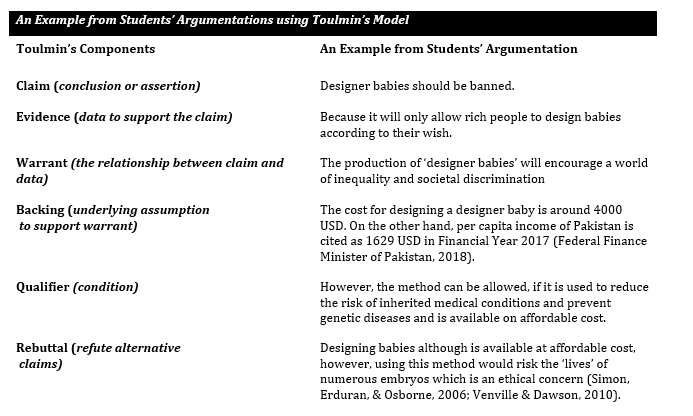Teaching through Case Study Method using Toulmin's Model of Argumentation
This story is written by Dr. Sadia Muzaffar Bhutta, Assistant Professor, Institute for Educational Development (IED), Pakistan
Being the eldest in the family, I started teaching my younger siblings at a very young age. After completing my Masters, I joined a local school and started teaching the way I was taught by my teachers. As an early career teacher, I was a strong believer of 'teacher-led' classrooms with 'slight touch' of student-talk. I started questioning this notion of pedagogical practice after being exposed to 'alternative' strategies of teaching which brought a paradigm shift in my notions and theories of teaching and learning. My espoused teaching philosophy is deeply rooted in constructivism, which relies on the nexus of 'active teaching' (teacher presents the content through interactive teaching) and 'active learning' (students take initiative to deconstruct and reconstruct knowledge and develop skills).
I view active teaching and learning as a 'balanced approach' in which both, the facilitator and the learners, actively participate to construct knowledge. Within this balanced approach, I find case studies to be an effective method because it enables the facilitators and learners to critically apply disciplinary concepts in authentic, real life, context.
An example from a Master of Education course called the Pedagogical Content Knowledge in Science clearly manifests the effectiveness of the case study method in improving students' learning. For one of the course themes, I generally use the case of the 'Designer's Baby' to engage students in argumentation while teaching socio-scientific issues. Students begin their learning cycle by exploring the case and sorting out the relevant facts and figures. Afterwards, they are involved in analyzing the information presented in the case, posing relevant questions, and developing logical conclusions through peer discussions. Based on their analysis, they take positions that require them to argue for or against the permissibility of a choice for parents to design their babies by selecting specific traits using the Toulmin's Model to frame their arguments and back/support their claims. Toulmin's model is the tool used for analyzing the components of arguments. Subsequently, they provide scientifically grounded arguments, expressing opinions, making decisions, and applying their learned theoretical concept in the given scenario. An example of the arguments developed by students using the Toulmin's Model is shown in the image below:

Evidently, the image shows that the learners argued for and against the Designer Baby case following the line of reasoning, whereby ethical and social considerations were demystified and discussed during the argumentation session in the class.
Many such experiences using the case study method for teaching and learning have led me to believe that it enhances students' cognition from merely recalling the information present in the scenario to a step ahead, where they are actively engaged in analyzing and evaluating the concepts and finally generating arguments to support their decision. Some of the students shared their views regarding this process as:
Argumentation [using case studies] generated a discussion in the classroom where we did not only begin to articulate reasons for supporting a particular claim and justify our views but we also started to listen to our peers' ideas, challenging them and then respond accordingly
Argumentation helps us to go beyond the memorization and superficial learning to a stage where we can actively integrate and apply concepts under an array of situations and circumstances
Having applied this strategy for over 5 years, I find case-based discussions effective in helping apply theoretical knowledge in daily life situations. This approach seems to have contributed to stretching the boundaries of the science classroom by applying the theory in real-life situations and connecting it to social, political, economic, religious and ethical issues.


